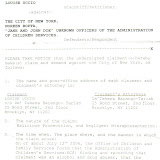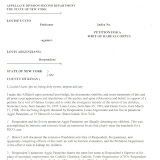Federal Action, Focused on Internet, Sets Off a Debate
By Jerry Markon
Washington Post Staff Writer
Saturday, December 15, 2007; A01
Lewd photographs of children were disappearing from adult bookstores. Child porn magazines in plain brown envelopes were no longer reaching customers through the mail. It was the early 1990s, and experts believed that federal law enforcement efforts were ending child pornography.
"We thought this was one of those rare forms of social deviance, of criminal behavior, that had been eradicated," said Ernie Allen, president of the National Center for Missing and Exploited Children. "Except for a fixated group of hard-core pedophiles, we thought it was gone."
But an increase of Internet-fueled child pornography has triggered a new federal crackdown. Cybercrime, the majority of which involves child pornography, is now the FBI's third-highest priority, behind counterterrorism and counterintelligence.
In the past 11 months, federal prosecutors in Virginia and Maryland have helped convict or send to prison on child pornography charges the former head of the Virginia American Civil Liberties Union, an Ivy League professor, a sheriff's deputy, a Transportation Security Administration employee, an Army sergeant, a former Navy cryptologist, a contractor working at Abu Ghraib prison in Iraq, a National Institutes of Health researcher and a U.S. Capitol Police officer.
"The problem is as bad as it appears," said Arnold E. Bell, unit chief of the FBI's Calverton-based Innocent Images National Initiative. "There are not enough badges out there to cover all the people to be had in terms of offenders."
The crackdown on child pornography is a lesser-publicized effort than the pursuit of people who solicit sex from minors and are arrested, often through sting operations, when they show up for an encounter with someone they meet on the Internet. And it has touched off a debate over how often this type of crime leads to molestation of children and whether viewing photographs warrants years in prisons.
Some defense lawyers and treatment professionals say that the focus on pornography has become excessive. Many caught in the dragnet, they say, viewed images for their private gratification but never intended to hurt a child.
"Sending people to prison for five or 10 or 15 years for looking at pictures is killing an ant with a sledgehammer," said Peter Greenspun, who defended Charles Rust-Tierney, the former ACLU head sentenced to seven years in prison for downloading hundreds of images. "These people are being put on sex-offender registries, they are being ostracized from the community, for looking at pictures."
But the nature of the images alarms law enforcement officials, who say Internet child pornography is increasingly sadistic and depicts young children whose victimization fuels a growing market.
Many defendants obsessively collect huge numbers of images -- the FBI recently seized a computer with 1.5 million images suspected to be child pornography -- and many have molested children, officials say. People who download the images once or twice, possibly by accident, are unlikely to be prosecuted, officials said.
"You can't wrap your brain around what we're talking about here," said Bonnie S. Greenberg, a prosecutor in the U.S. attorney's office in Maryland. "We're not talking about a 16-year-old who looks like she could be 19. We're seeing prepubescent children who are being raped, babies, toddlers being tied up."
Underlying the debate are efforts by researchers to understand the perpetrators. Do people who view the images harbor a latent sexual interest in children that the Internet brings out, or does the Internet prompt the urges? And will people who view child pornography molest children?
Michael Seto, a Canadian researcher, said he thinks that an "invisible population of pedophiles" has lived in society all along but remained mostly hidden until the Internet offered relative anonymity and a community of like-minded people.
Whatever the role of the Internet, few dispute that it is the conduit for pornographic photos, films, videos and computer-generated images of children in lewd poses or involved in sexual conduct.
The National Center for Missing and Exploited Children's CyberTipline received about 4,500 reports of children being victimized it its first year, 1998. This year the center, which works closely with law enforcement officials, has collected nearly 100,000 reports, more than 75 percent for online child pornography.
But an increase in federal cases -- a 28 percent spike in fiscal 2007 compared with the year before -- could partly be due to a rise in the number of agents attacking the problem. "Are there more offenses, or are we doing a better job? I think it's safe to say it's both," said Drew Oosterbaan, chief of the Justice Department's child exploitation and obscenity section.
The frequency at which people who view child pornography also molest children is a highly controversial issue and has been the subject of little research. The only federal agency that tries to track the correlation, the U.S. Postal Inspection Service, says that about one-third of the 2,713 people it has arrested since 1997 on child exploitation charges, primarily for trafficking in child pornography, also committed "contact offenses" against children.
A recent study of 155 federal inmates in North Carolina convicted on child pornography charges suggests that the number is higher. It found that 85 percent admitted molesting children. The study's co-author, Andres Hernandez, told Congress last year that "these Internet child pornographers are far more dangerous to society than we previously thought."
But some people who treat sex offenders say the risk is often minimal. "There are a large group of individuals whose lives and families are absolutely being devastated because they looked at these images," said Fred Berlin, a psychiatrist who runs the National Institute for the Study, Prevention and Treatment of Sexual Trauma, affiliated with Johns Hopkins University. "They had absolutely no idea how severe the consequences would be and had no interest in doing anything other than viewing images."
Child pornography first became an issue in the United States when nude photographs of children and adults began entering the country after the Civil War. A postal inspector, Anthony Comstock, drafted the first federal obscenity law, passed by Congress in 1872.
For nearly a century, however, there were few prosecutions, because there was no specific child pornography law. People obtained photographs and magazines through the mail or by quietly trading them or buying them at adult bookstores, which often kept child pornography behind the counter.
The first federal crackdown began after Congress passed a 1978 law banning commercial distribution of child pornography, and the Supreme Court ruled in 1982 that child pornography amounted to abuse and had no free speech protections.
Although child pornography seemed to have almost vanished by the early 1990s, the Internet changed everything. "Previously, someone would have to put on a trench coat, drive to the seedy part of town and walk to the back room of the adult bookstore," said Chuck Rosenberg, the U.S. attorney in Alexandria. "Now it's just a few keystrokes away."
Federal and state task forces are multiplying, and U.S. Immigration and Customs Enforcement runs the Cyber Crimes Center in Fairfax County, which focuses on the international component.
Last year, the Justice Department unveiled Project Safe Childhood, which coordinates the fight against all child sexual exploitation but emphasizes child pornography. Attorney General Michael B. Mukasey made it clear at a recent conference that the campaign against what he called "the sort of evil that is exchanged in dark corners of the Internet" will continue.
"Simply put, our children need our protection," he said.
Subscribe to:
Post Comments (Atom)























No comments:
Post a Comment